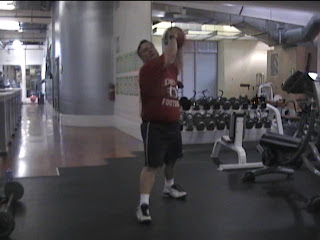I've previously posted on the value of retro training as an important part of the recovery/restoration process, but a recent conversation with fellow GAINer Chris Webb got me thinking. I did some research into lower back pain in swimmers. Apparently the stroke doesn't have too much to do with it. The consensus seems to be the hyperlordosis created by the aquatic environment. As a result, most of the treatments I've read involve pelvic stability stuff. Consider a few other things.
The T-Spine: This section of the spine is susceptible to Fryett's type 3 motion...that is, if one or more joints are locked up in one plane, that dysfunction will also carry over to the other two planes. Most "movement screens" involve the transverse plane. In my clinical experience, this is the "go-to" plane. In other words, this is the plane that has the most range of motion in the T-spine. So it can trick you. The frontal plane in both directions, and the sagittal plane in the posterior direction are the most affected in T-spine dysfunction.
The T-spine is a trouble maker; the lumbar spine a hit taker. Since swimming is primarily driven by the hands top down, it might be possible that the T-spine is stealing the motion it doesn't have from the lumbar spine.
Retro-Training: Janda coined the term "pattern overload", meaning sports that require repetitive motion in one plane in one direction (ie cricket bowling, pitching, swimming, running) may result in muscle & joint imbalances. Simply doing some training in the opposite direction, or with the opposite hand my be beneficial in ameliorating this.
I'm suggesting two more variations- environment & orientation to gravity. Using swimming as an example, simply switching from the Australian crawl (yeah, that's right, the Aussies invented the freestyle stroke) to the backstroke is probably not effective. The reason being the body is essentially weightless. To produce the retro effect I'm thinking you would need to go dryland/horizontal supine or full weight bearing. Adding exercises to the athlete's repertoire like jackknifes, pencil rolls, reverse crunches (horizontal); posterior lunge-overhead medball combos, dropstep- overhead exercise band combos (FWB).
Please chime in, even if you think I'm full of it- especially if you think I'm full of it!
Friday, November 26, 2010
Subscribe to:
Post Comments (Atom)



3 comments:
Joe,
I agree with you that the T-spine is a troublemaker & often neglected region of focus.
Your exercise suggestions make good sense.
Kevin Moody
Probably also related to crossed pelvis and upper trunk syndromes coined by Janda. By putting resistance in the muscles that are repetitive antagonists you're lengthening the muscles that are repetitive agonists....
Post a Comment